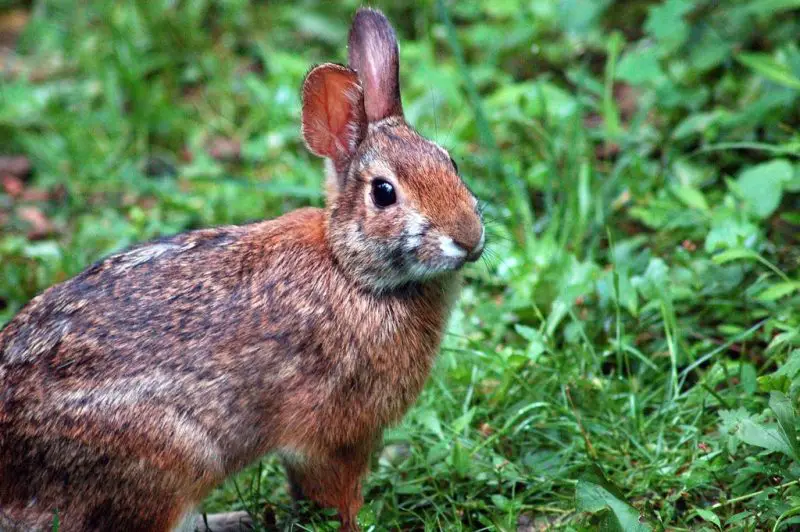Tennessee is home to three prominent species of wild rabbits: the Eastern Cottontail (Sylvilagus floridanus), the Appalachian Cottontail (Sylvilagus obscurus), and the Swamp Rabbit (Sylvilagus aquaticus). Each species has unique physical characteristics, behaviors, and habitats that contribute to the state’s rich biodiversity. Observing these rabbits in the wild can be a rewarding experience for nature enthusiasts, photographers, and wildlife watchers alike.
Wild rabbits play an essential role in Tennessee’s ecosystems. They serve as prey for various predators, including hawks, foxes, and bobcats, while also helping to shape plant communities through their feeding habits. Understanding the distinctions among these species is crucial for proper identification, conservation efforts, and habitat management.
From lowland swamps to high-elevation thickets, Tennessee provides an array of habitats that sustain these three rabbit species. Each has adapted to thrive in specific environmental niches, displaying fascinating behaviors that reflect their survival strategies. This guide will provide detailed information on their characteristics, size, behavior, habitat, fun facts, and distribution.
Eastern Cottontail (Sylvilagus floridanus)

Identification and Physical Features
The Eastern Cottontail is the most widespread rabbit species in North America and is abundant throughout Tennessee. It has soft, dense fur with a grayish-brown to reddish coloration on its back and a distinctive white fluffy tail. Its ears are relatively long, and its eyes are large, aiding in predator detection. The Eastern Cottontail’s hind legs are strong and well-suited for rapid escape, often enabling sudden bursts of speed to evade predators.
Size and Behavior
Adult Eastern Cottontails typically measure 15–19 inches (39–48 cm) in length and weigh between 4–5 pounds (1.8–2.2 kg). They are primarily herbivorous, feeding on grasses, clover, leaves, buds, and bark. These rabbits are crepuscular, most active during dawn and dusk, and usually seek cover in brush, tall grass, or burrows during the day. They rely on a combination of camouflage, quick dashes, and zig-zag running patterns to avoid predation.
Habitat and Distribution
Eastern Cottontails thrive in open fields, meadows, brushy areas, farmlands, and even suburban yards. They are highly adaptable and are found in every county of Tennessee. Their broad distribution makes them the easiest wild rabbit to observe in the state. Eastern Cottontails are known to create small forms, shallow depressions in the grass where they rest and hide from predators.
Fun Fact
Despite being common, Eastern Cottontails are excellent at evading predators. Their white tail is thought to act as a visual distraction, momentarily confusing predators during a high-speed escape. Additionally, they are prolific breeders, with females capable of producing several litters of 3–7 kits each year.
Appalachian Cottontail (Sylvilagus obscurus)

Identification and Physical Features
The Appalachian Cottontail is a rarer species, confined primarily to the higher elevations of eastern Tennessee and the Appalachian Mountains. It is slightly smaller than the Eastern Cottontail, with darker fur that blends into the dense thickets and coniferous forests of its habitat. Its white tail is less prominent, and its overall appearance is more muted, which helps with camouflage in mountainous terrain.
Size and Behavior
Adults typically range from 13–16 inches (33–41 cm) in length and weigh 3–4 pounds (1.4–1.8 kg). Like other cottontails, it is herbivorous, feeding on a variety of vegetation including leaves, stems, berries, and mountain shrubs. Appalachian Cottontails are shy and elusive, often staying hidden within dense brush. They are primarily nocturnal or crepuscular, using thickets and fallen logs for cover.
Habitat and Distribution
This species is specialized for upland areas, preferring dense thickets, rocky slopes, and understory vegetation in cooler, higher-elevation habitats. In Tennessee, sightings are mostly reported in the Appalachian regions of the eastern counties and some parts of the Cumberland Plateau. The Appalachian Cottontail’s limited distribution makes it less frequently observed than its Eastern counterpart.
Fun Fact
The Appalachian Cottontail has evolved to survive in colder, rugged terrain, and its muted coloration helps it remain nearly invisible to predators. It is considered a conservation concern due to its restricted range and specialized habitat requirements, highlighting the importance of protecting high-elevation forests in eastern Tennessee.
Swamp Rabbit (Sylvilagus aquaticus)

Identification and Physical Features
The Swamp Rabbit is the largest cottontail species in the southeastern United States. It has long legs and a robust body, with coarse fur that is generally darker than the Eastern Cottontail. The tail is white underneath, and its ears are long but slightly rounded at the tips. Adapted to wetland environments, the Swamp Rabbit is an excellent swimmer, with webbed hind feet that aid in water navigation.
Size and Behavior
Adults range from 17–22 inches (43–56 cm) in length and can weigh between 5–7 pounds (2.3–3.2 kg). Swamp Rabbits are primarily nocturnal and spend much of their time near water bodies such as swamps, rivers, and marshes. When threatened, they often escape by plunging into water, swimming away with only their nose above the surface. Their diet consists mainly of grasses, aquatic plants, and bark.
Habitat and Distribution
Swamp Rabbits are generally found in western and some central regions of Tennessee, favoring swampy areas, bottomlands, and wetlands. Their reliance on water-rich habitats makes them less common in dry upland areas. Dense vegetation along riverbanks provides shelter, while wetlands support their aquatic escape strategies. They are more localized than the Eastern Cottontail but are relatively easier to spot in suitable habitats.
Fun Fact
Swamp Rabbits can swim across ponds and rivers to evade predators, a rare skill among rabbits. They have even been observed diving underwater to hide from threats, demonstrating remarkable adaptability for a mammal usually associated with terrestrial habitats.
Best Time and Places to See Wild Rabbits in Tennessee
Wild rabbits in Tennessee can be elusive, but knowing their preferred habitats and activity patterns can greatly improve your chances of spotting them. Observing these species is most successful during the cooler parts of the day when they are naturally active.
Eastern Cottontail
The Eastern Cottontail is most active during dawn and dusk, known as crepuscular behavior. They are commonly found in open fields, meadows, pastures, and the edges of forests. Suburban gardens and agricultural areas also provide good opportunities for observation. Early mornings in spring and fall offer the best sightings, as rabbits forage for fresh vegetation after cooler nights.
Appalachian Cottontail
Appalachian Cottontails are shy and primarily inhabit higher-elevation thickets and forests. They are most active at night or during twilight hours. The best places to observe them are in the dense undergrowth of the Appalachian Mountains and the Cumberland Plateau in eastern Tennessee. Late spring to early summer provides optimal conditions, as the vegetation is dense enough to shelter them while still allowing glimpses for careful watchers.
Swamp Rabbit
Swamp Rabbits are strongly associated with wetlands and riparian areas. Observing them during early morning or evening along riverbanks, swamps, and marshy bottomlands yields the best results. They often stay hidden during the day but may be seen feeding near water at dusk. Western and central Tennessee regions with abundant wetlands offer prime locations, particularly in areas where river channels create secluded pockets of vegetation.
By visiting these habitats during the right times of day and season, wildlife enthusiasts and photographers can increase their chances of encountering Tennessee’s wild rabbits in their natural environments. Patience, quiet movements, and binoculars are key tools for successful observation.
Conservation and Observing Wild Rabbits in Tennessee
Wild rabbits are not only important components of Tennessee’s ecosystems but also popular subjects for wildlife observation. Maintaining habitat diversity, including meadows, brushy edges, wetlands, and forested areas, supports healthy rabbit populations. Hunting regulations, habitat conservation, and monitoring are essential to ensure sustainable populations of all three species.
When observing wild rabbits, patience and quiet are key. Eastern Cottontails are easier to spot due to their widespread distribution, whereas Appalachian Cottontails and Swamp Rabbits require knowledge of specific habitats. Binoculars, early morning or dusk excursions, and careful observation along thickets and wetlands increase the chances of sightings.
Rabbits’ roles as prey species make them crucial for predators, contributing to the balance of Tennessee’s ecosystems. Additionally, their selective feeding impacts plant community structure, aiding in forest regeneration and wetland maintenance. These fascinating mammals offer insight into the complex interdependence of flora and fauna.
Conclusion
Tennessee’s three wild rabbit species—the Eastern Cottontail, Appalachian Cottontail, and Swamp Rabbit—each showcase unique adaptations, behaviors, and habitat preferences. From the widespread and adaptable Eastern Cottontail to the elusive Appalachian Cottontail and the aquatic Swamp Rabbit, these species enrich the state’s natural landscapes. Observing and understanding them enhances appreciation for Tennessee’s wildlife diversity and emphasizes the importance of habitat preservation.
FAQs About Wild Rabbits in Tennessee
What species of wild rabbits live in Tennessee?
Tennessee is home to three native species of wild rabbits: the Eastern Cottontail (Sylvilagus floridanus), the Appalachian Cottontail (Sylvilagus obscurus), and the Swamp Rabbit (Sylvilagus aquaticus). Each has unique physical traits, behaviors, and habitat preferences.
How can I identify an Eastern Cottontail?
Eastern Cottontails are medium-sized rabbits with grayish-brown to reddish fur, a white fluffy tail, and long ears. They are commonly found in open fields, meadows, and suburban areas throughout the state.
Where is the best place to see Appalachian Cottontails?
Appalachian Cottontails are found in higher-elevation areas of eastern Tennessee, especially in dense thickets and forests of the Appalachian Mountains and Cumberland Plateau. They are shy and mostly active at twilight or night.
What makes Swamp Rabbits unique?
Swamp Rabbits are larger than other cottontails and are excellent swimmers. They prefer wetlands, swamps, and river bottomlands in western and central Tennessee. When threatened, they may dive into water to escape predators.
When is the best time to observe wild rabbits?
Wild rabbits are generally most active during dawn and dusk. Early morning and evening excursions in their preferred habitats increase the chances of sightings.
What do wild rabbits eat?
Wild rabbits are herbivorous. Eastern and Appalachian Cottontails feed on grasses, leaves, buds, and berries, while Swamp Rabbits consume aquatic plants, grasses, and bark along wetland areas.
Are any of these rabbits endangered or protected in Tennessee?
The Eastern Cottontail and Swamp Rabbit are widespread and not currently threatened. The Appalachian Cottontail is rarer due to its restricted high-elevation habitat, making conservation of forested areas important for its survival.
Can I photograph wild rabbits safely?
Yes. Approach slowly, maintain quiet, and use binoculars or a zoom lens to avoid disturbing them. Dawn and dusk provide optimal lighting and activity for photography.






